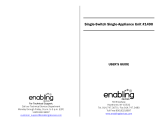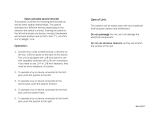
Mode
Button
The Mode button allows you
to navigate through the available
operating Modes for the control system. The available modes
are dependent on programing and the range of auxiliary output
devices connected to the control system. When in any Mode
other than Drive and Setting the Speed and Actuator LEDs are
all extinguished.
Actuator Indicator
This LED set displays which Actuator channel is currently being
controlled when the Control System is in Actuator Mode.
Actuator selection and operation is achieved using the Joystick.
Motions to the Left or Right select different actuator channels.
Motions Forward and Backwards move the actuator(s)
selected.
Charger Socket (Fig 3.6
This socket should only be used for charging the wheelchair.
Do not connect any type of programing cable into this socket.
Refer to section 9.0 for more details on charging.
This socket should not be used as a power supply for any other
electrical device. Connection of other electrical devices may
damage the control system or affect the electromagnetic
compatibility (EMC) performance of the wheelchair.
The control system warranty will be voided if any device other
than the manufacturer approved battery charger is connected
to this socket.
Assignable Buttons
Via programing, it is possible to change the function of most of
the buttons. This includes assigning the function of another
button or making the button act as a shortcut to a particular
action, such as moving a seating function. Additionally, a button
can be assigned a second function, which is accessed by
depressing the button for a length of time.
For more information on changing the function of a button and
assigning a second function, please contact your
authorized
dealer.
3.4 Joystick Module With LED Buttons (Fig 3.5
)
Battery Gauge
The battery gauge shows you that the wheelchair is switched
on. It also indicates the operating status of the wheelchair.
Details are given in section 5.0.
If the battery gauge shows red, yellow, and green, the batteries
are charged. (LEDs 1 – 10)
If the battery gauge shows just red and yellow, then you should
charge the batteries as soon as you can. (LEDs 1 – 7)
If the battery gauge shows just red, either steady or flashing
slowly, then you should charge the batteries immediately.
(LEDs 1 – 3)
Do not operate the control system if the battery is nearly
discharged. Failure to comply with this condition may leave you
stranded in an unsafe position, such as in the middle of a road.
Sunrise Medical accepts no liability for losses of any kind
arising from failure to comply with this condition.
Refer to section 5.0 for details.
Maximum Speed / Profile Indicator
This is a gauge which shows the maximum speed setting for
the wheelchair or, if the control system is programmed for drive
profile operation, the
selected drive profile.
This gauge also indicates if the speed of the wheelchair is
being limited or if the control system is locked, refer to section
5.21.
Maximum Speed
Indicator
When programmed to display speeds, this gauge shows the
maximum speed setting of the wheelchair. There are five speed
settings – step 1, (1 LED, is the lowest speed) and Step 5,
(5 LEDs), is the highest speed.
Profile Indicator
When programmed to display profiles, this indicator shows the
selected drive profile. There may be up to five
drive profiles
available; this depends on the programing of the control
system. Drive profiles can be programmed into the controller. A
Control System utilizing an JSM-LED should only be
programmed with five Profiles enabled. For programing
information, please contact your authorized
dealer.
Speed / Profile Decrease Button
Pressing this
button decreases the maximum speed setting
or,
if the control system is programmed for drive profile operation,
selects a lower drive profile.
Speed / Profile Increase Button
Pressing
this button increases the maximum speed setting or,
if
the control system is programmed for drive profile operation,
selects a higher drive profile.
R-Net Control System w/Omni2





















